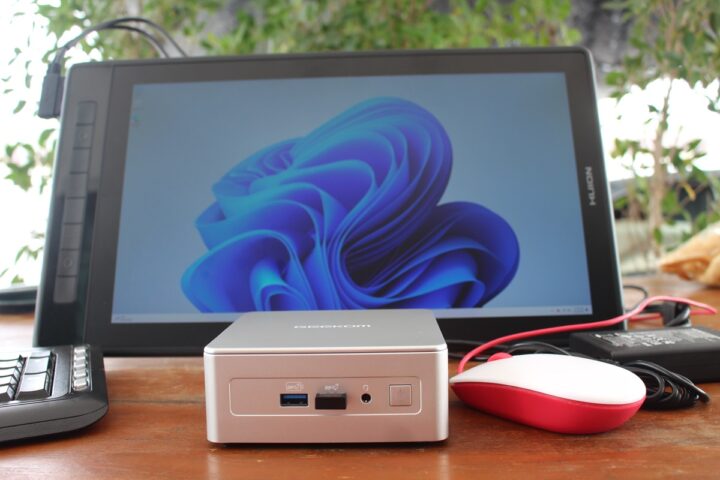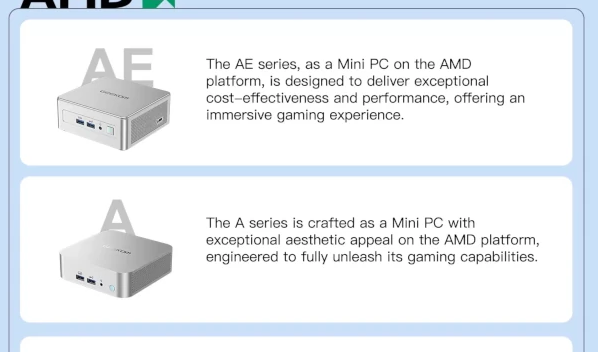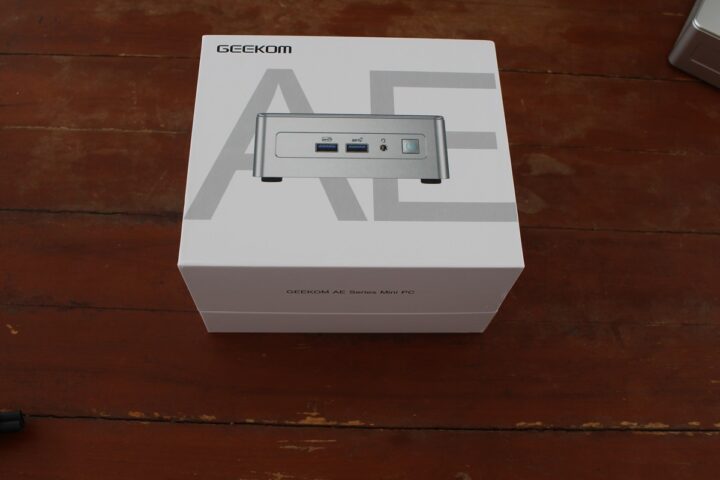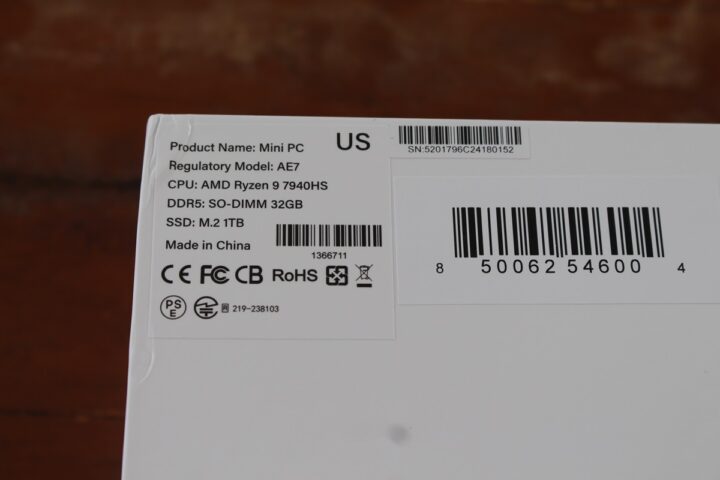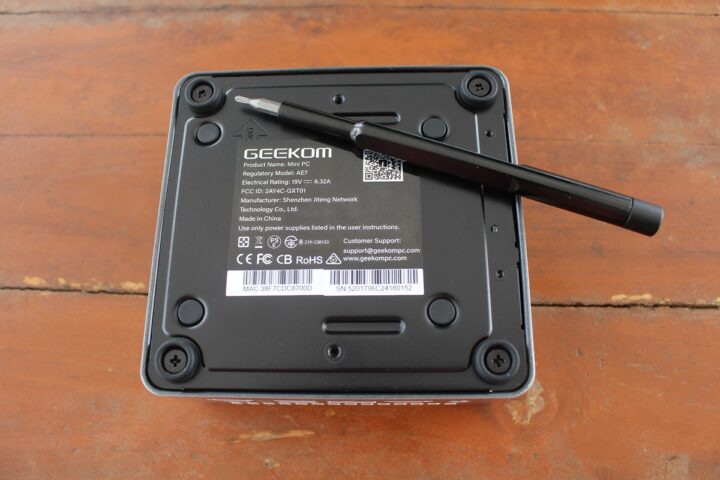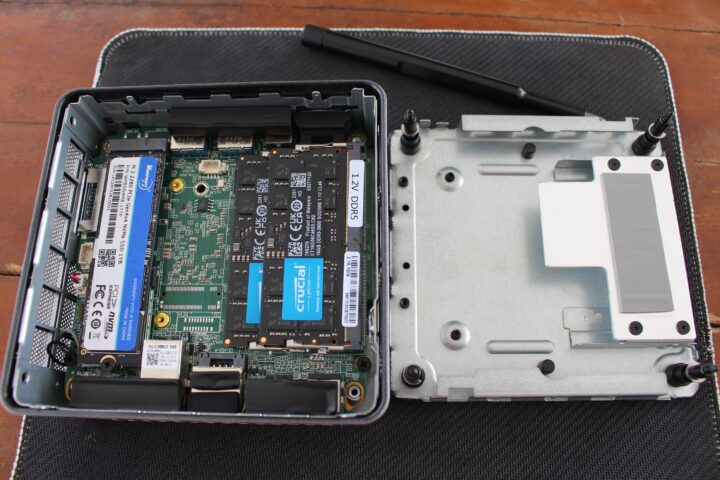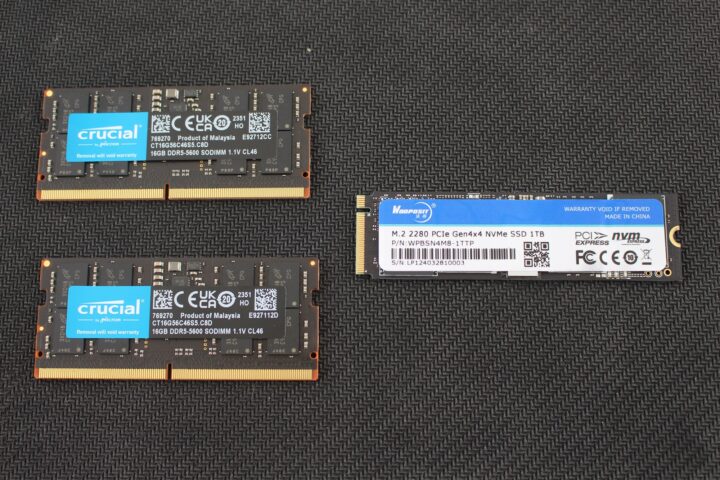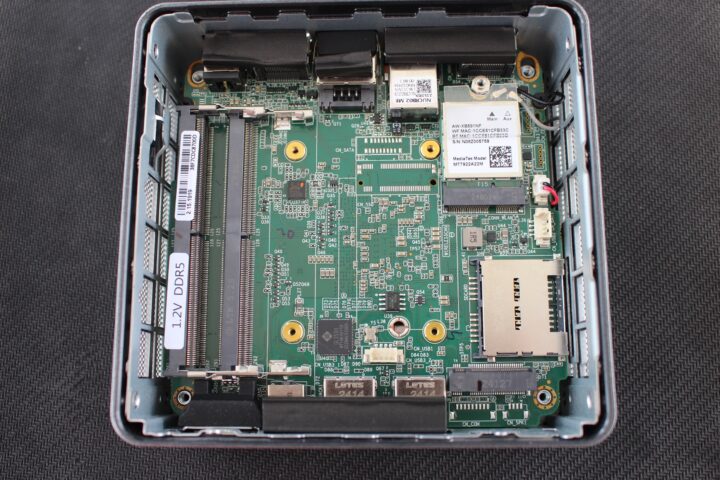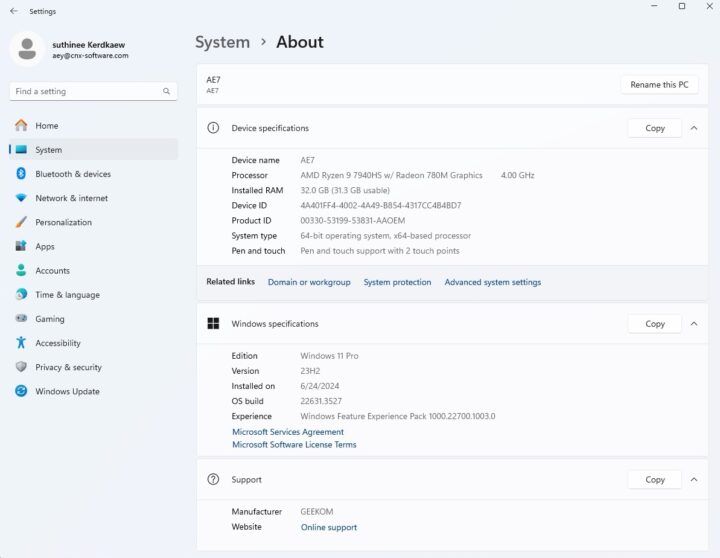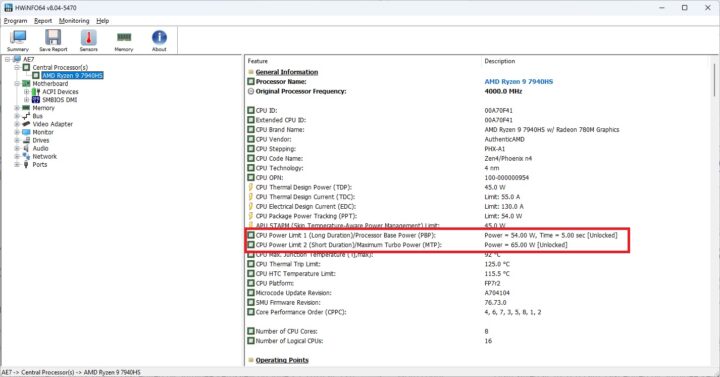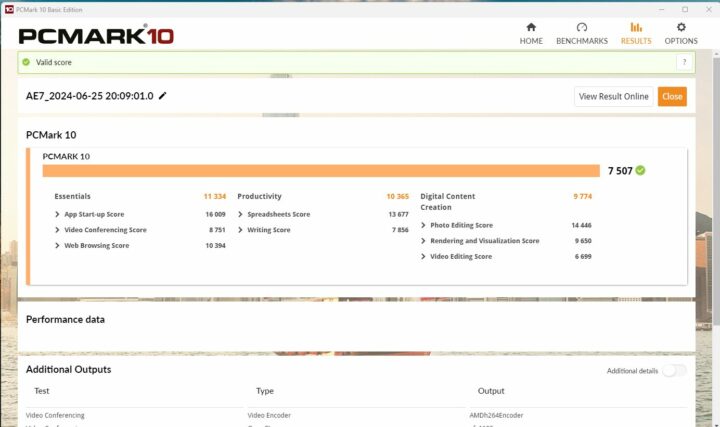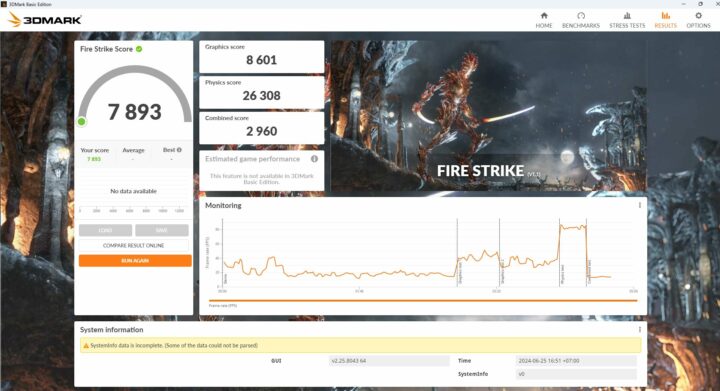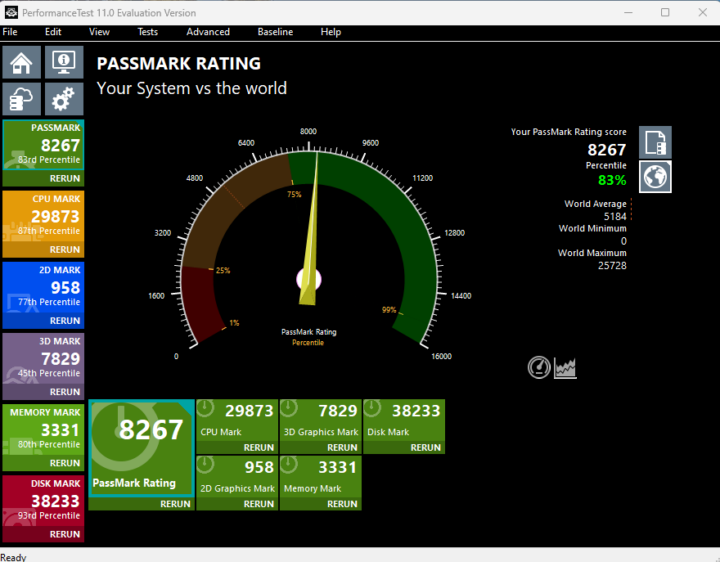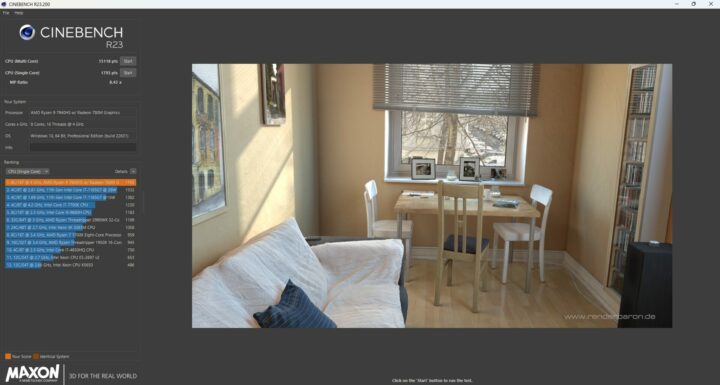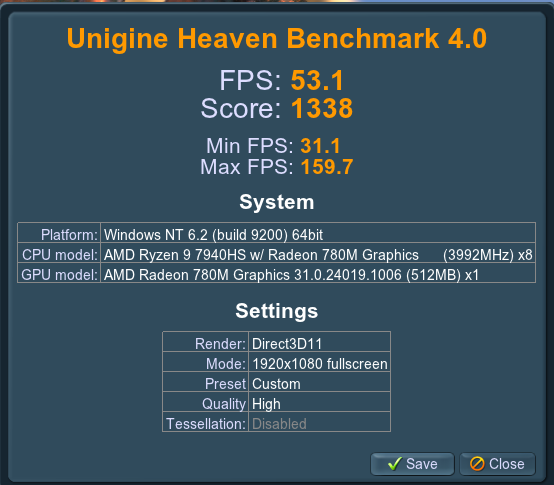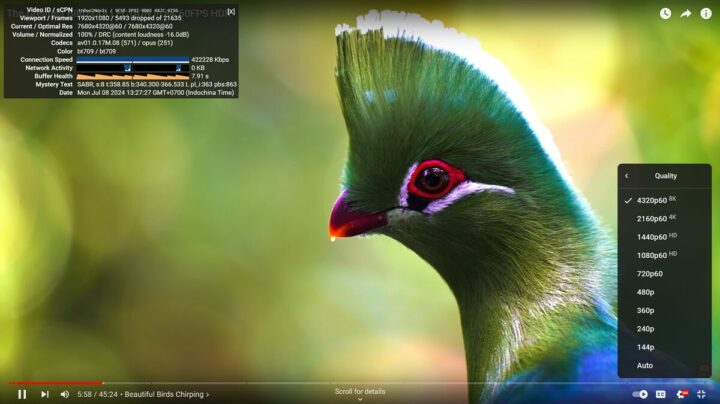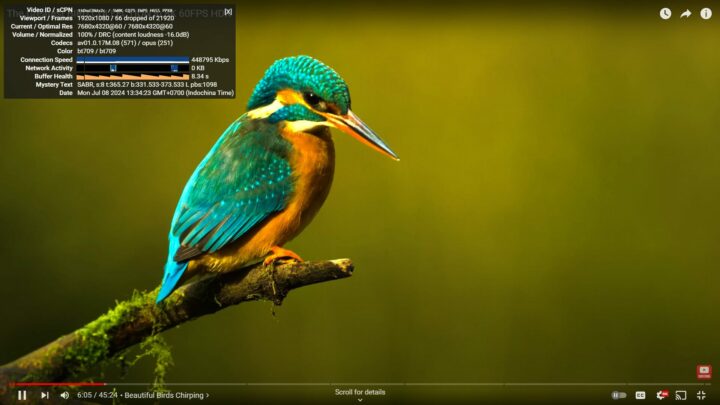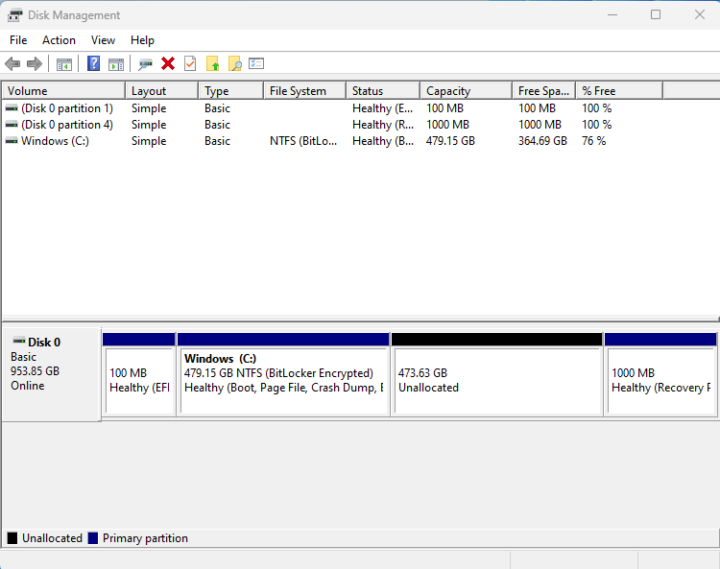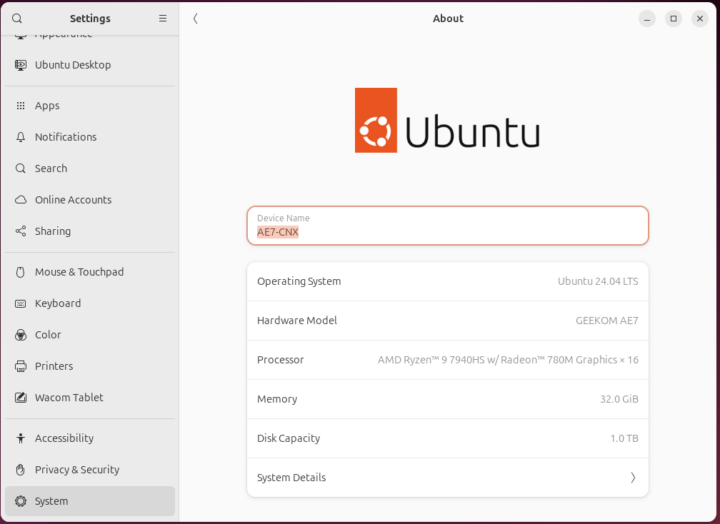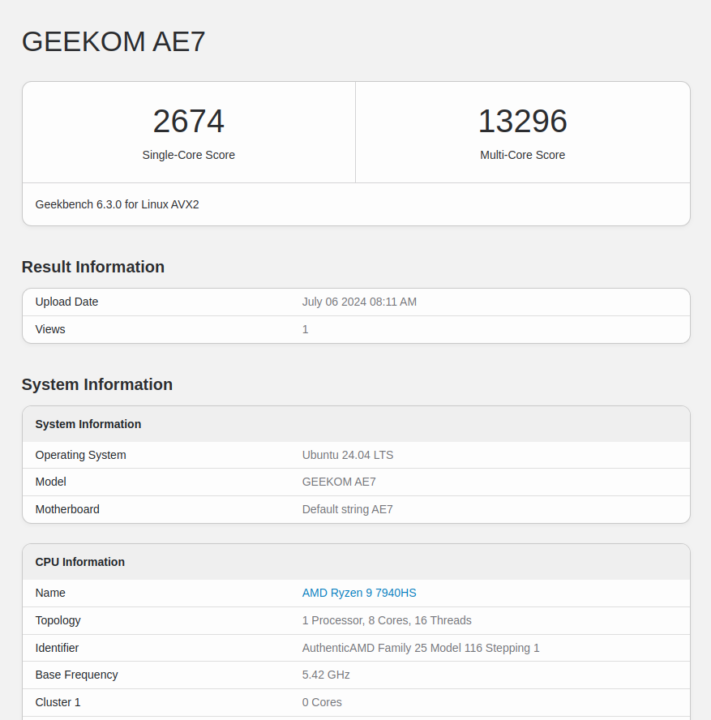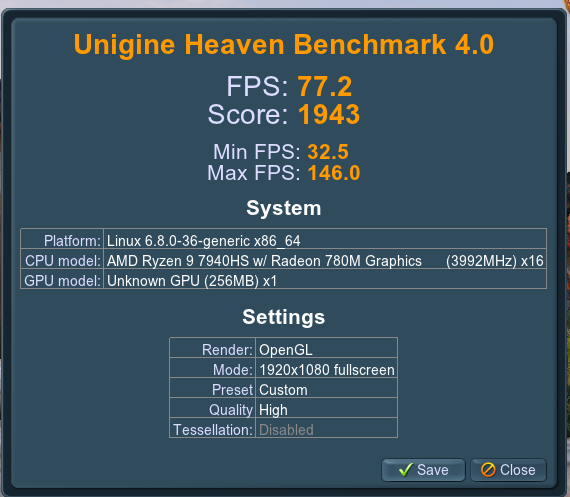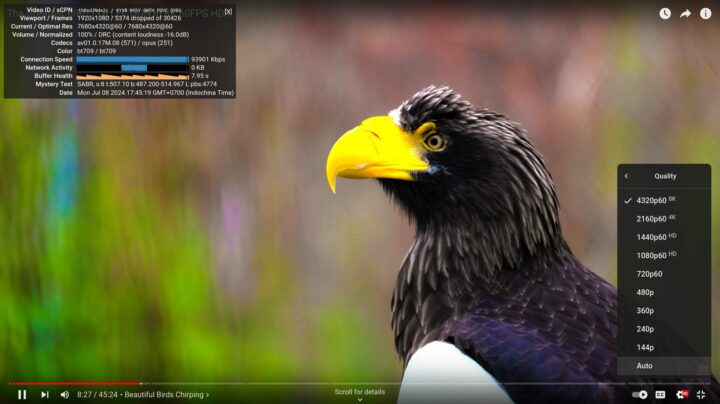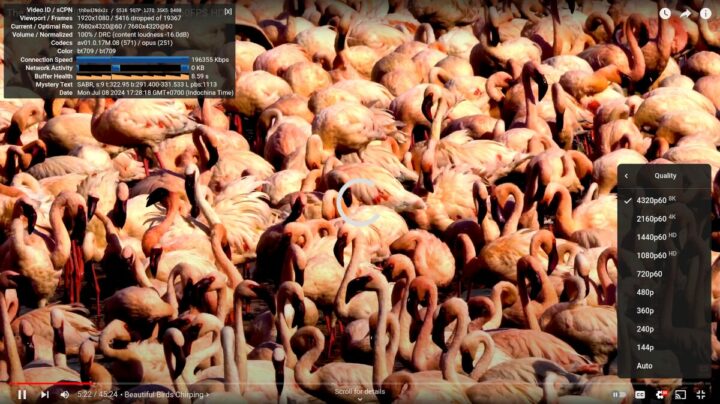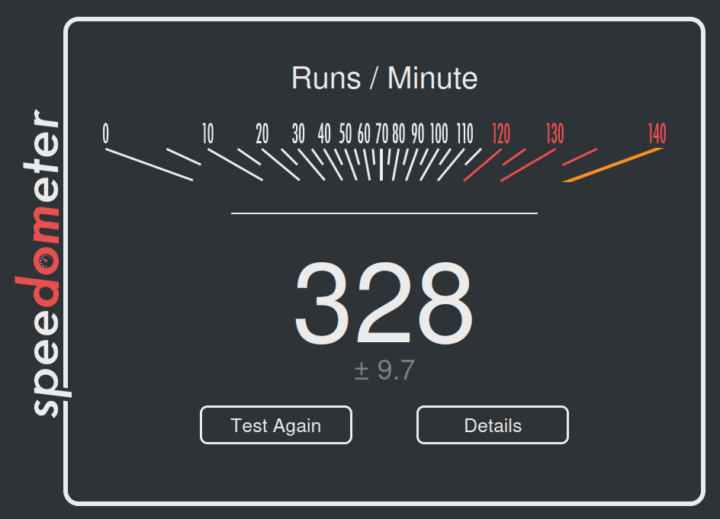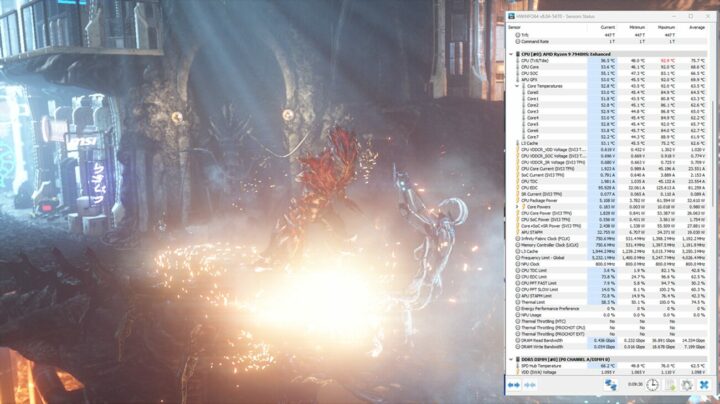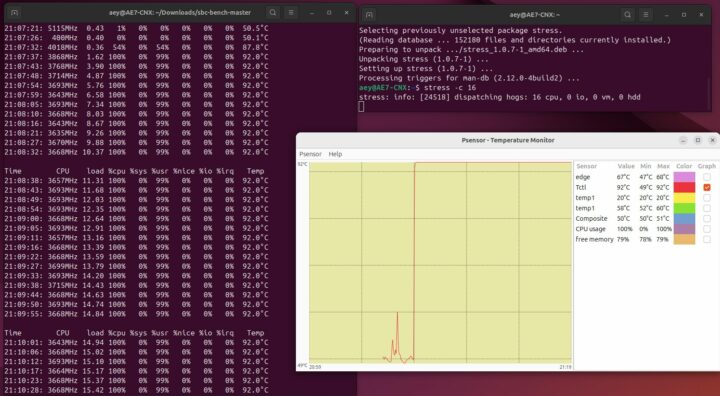Today we’ll review the GEEKOM AE7 mini PC powered by an AMD Ryzen 9 7940HS octa-core processor with up to 32GB DDR5, a 1TB NVMe SSD, four 4K capable video outputs through HDMI and USB-C ports, 2.5GbE and WiFi 6E connectivity, and six USB ports for expansion.
As its name implies the GEEKOM AE7 is an evolution of the earlier GEEKOM A7 with almost identical specifications that we reviewed with Windows 11 Pro and Ubuntu 22.04 earlier this year. So we won’t do our usual three-part review and instead focus on differences between the two Ryzen 9 7840HS mini PCs in terms of features, performance, and cooling ability in a shorter review that covers hardware, Windows 11 Pro, and Ubuntu 24.04 testing.
GEEKOM AE7 specifications
- SoC – AMD Ryzen 9 7940HS 8-core/16-thread processor up to 4.0GHz with 16MB cache, AMD Radeon 780M Graphics; TDP: 35 to 54W
- System Memory – Up to 64GB dual-channel DDR5-5600 via 262-pin SODIMM sockets
- Storage
- Up to 2TB NVMe PCIe x4 Gen 4 SSD
- Full-size SD card reader
- Video Output
- 2x HDMI 2.0 ports up to 4Kp60
- 2x USB-C ports with DisplayPort Alt. mode
- Audio – 3.5mm audio jack, digital audio via HDMI ports
- Connectivity
- 2.5GbE RJ45 port via a Realtek RTL8125BG-CG controller
- WiFI 6E and Bluetooth 5.3
- USB
- 3x USB 3.2 Gen 2 Type-A ports
- 1x USB 4 Gen3 Type-C port
- 1 x USB 3.2 Gen 2 Type-C port
- 1 x USB 2.0 Type-A port
- Misc – Power button with LED, Kensington lock
- Power Supply – 19V (120W) via DC jack
- Dimensions –
112.4 x 112.4 x 37 mm117 x 112 x 49.2 mm
The mini PC comes preloaded with Windows 11 Pro. We’ve highlighted the differences in bold and strike-through in the specifications above, and basically, the GEEKOM A7 and AE7 mini PCs are the same except for the size and the AE7 adds a Kensington lock slot. One difference not shown in the specifications is the GEEKOM AE7 is fitted with the “IceBlast 1.5” cooling system developed by GEEKOM with “low noise and high airflow to dissipate heat faster”. We’ll see how this performs during the fan noise testing and stress tests.
The illustration below shows the difference between the AE series and A series families both of which are equipped with AMD processors.
The AE series is designed for cost-effectiveness and the A-series offers a slimmer design. Both series are suitable for games due to the superior performance of the built-in AMD Radeon GPU compared to the equivalent Intel UHD/Xe graphics. A GEEKOM AE8 model based on the GEEKOM A8 with an AMD Ryzen 9 8945HS processor is also available.
GEEKOM AE7 unboxing
The retail package is different with a white design instead of a black one for the A7.
As usual, we recommend checking out key specifications on the bottom of the package to make sure you’ve received the right model. We got an AE7 mini PC with an AMD Ryzen R9 7940S CPU, 32GB DDR5 SO-DIMM memory, and a 1TB M.2 SSD as expected.
The GEEKOM AE7 mini PC ships with the same accessories as the GEEKOM A7 including a 120W power adapter, an HDMI Cable, User Guide and Thank You Card. It also adds a VESA mount and screw set that are not found in the A7 since the case for the latter has a different design and is not compatible with VESA mounts.
All main ports are the same. The front panel features two USB 3.2 ports, a 3.5mm headphone jack, and a power button, and the rear panel comes with a 19V DC jack, a USB4 port with DisplayPort Alt mode, one HDMI 2.0 port, a 2.5GbE RJ45 jack, one USB 3.2 Type-A port, one USB 2.0 Type-A port, one USB 3.2 Type-C port with DisplayPort Alt. mode, and another HDMI 2.0 port. Some openings can also be found on the top for ventilation.
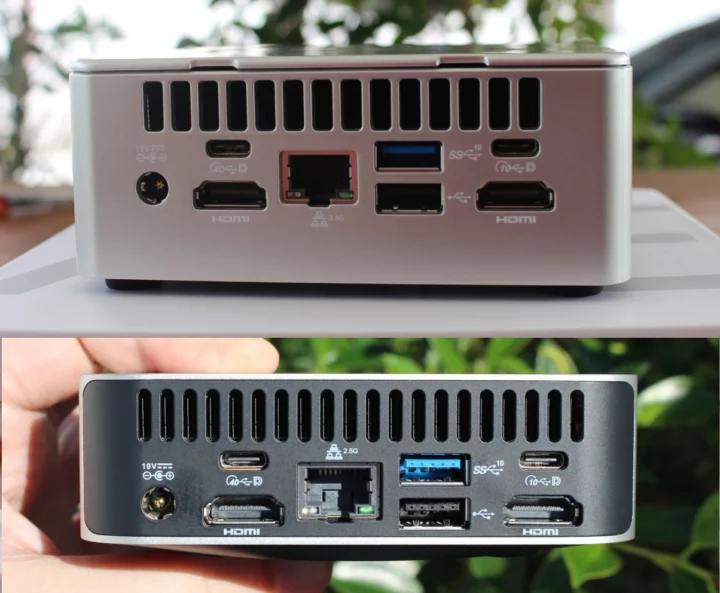
As noted in the specifications, the GEEKOM AE7 is thicker, but for no specific reason since the 2.5-inch SATA bay can not be used due to the lack of a SATA connector inside. The company just reused an existing enclosure.
One of the sides is equipped with a full-size SD card slot like in all GEEKOM mini PCs we’ve reviewed so far, and the other comes with a Kensington lock slot missing from the GEEKOM A7.
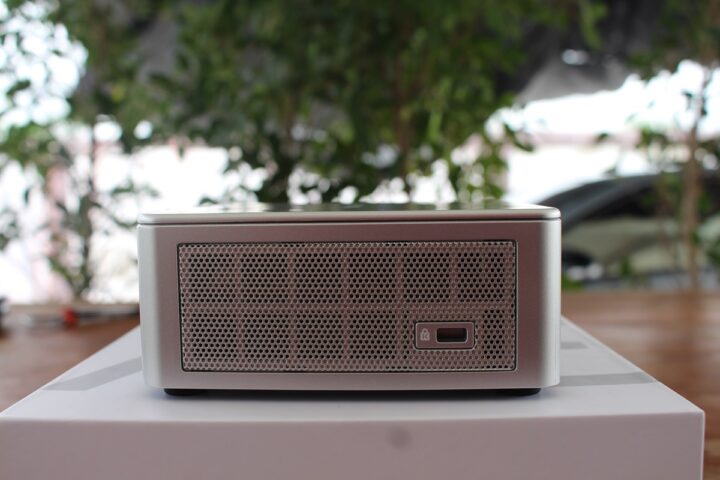
GEEKOM AE7 teardown
Time for a teardown. The bottom side is completely different between the GEEKOM A7 and AE7, as in the A7 we had only four screws hidden behind four rubber pads. The GEEKOM AE7 offers an easier-to-open and more rugged case that also happens to have four more holes for the VESA mount.
We can see the SATA bay on the bottom cover, but contrary to other GEEKOM mini PCs with that case, the GEEKOM AE7 does not have a SATA connector.
We don’t have to worry about damaging the WiFi antenna when opening the computer on this model because the antenna isn’t attached to the cover. The GEEKOM AE7 mini PC comes with two 16GB Crucial DDR5-5600 memory sticks for 32GB RAM in total and a 1TB Wooposit M.2 2280 PCIe Gen 4 x4 SSD 1 TB, while our GEEKOM A7 sample was equipped with the same 16GB Crucial DDR5-5600 memory sticks, and a 2TB ACER M.2 2280 PCIe Gen 4 x4 SSD.
The motherboard for the GEEKOM A7 and AE7 mini PC is exactly the same, and both models use the MediaTek MT7922-based Azurewave AW-XB591NF Wi-Fi 6E and Bluetooth 5.3 wireless module.
Windows 11 system information
We’re not going to do much in this section since the GEEKOM A7 and AE7 are almost identical. We invite you to read the GEEKOM A7 Windows 11 overview section for more details.
The System->About window in the settings confirms we have an AE7 device with a 4.0 GHz (base frequency) ADM Ryzen 9 7940HS with Radeon 780M Graphics and 32GB RAM running Windows 11 Pro 23H2.
One potential difference between the A7 and AE7 could be the power limits.
PL1 (Long Duration) is set to 54W and PL2 (Shirt Duration) to 65W while they were set to 45W and 60W respectively on the GEEKOM A7. In theory, that means we could have slightly better performance in the GEEKOM AE7 during short bursts.
GEEKOM AE7 benchmark on Windows 11
Let’s start the benchmarks with PCMark 10 to evaluate overall system performance.
The GEEKOM AE7 achieved 7,507 points.
Next up is 3DMark Fire Strike benchmarks testing both the GPU and CPU capability. The Ryzen 9 7940HS mini PC got 7,893 points here.
That would be 8,6267 points in PassMark PerformanceTest 11. The Disk Mark result is pretty decent, so let’s run CrystalDiskMark to further confirm the performance of the 1TB NVMe SSD. It can transfer data a 4,945.28 MB/s (read) and 4,287.01 MB/s (write), while the 2TB ACER SSD in the GEEKOM A7 achieved similar results at 4,906.30 MB/s and 4,710.80 MB/s respectively. Random I/Os results are also similar for the two SSDs.
Cinebench is used to test the single-core and multi-core performance of the AMD Ryzen 9 7940HS processor and the cooling efficiency of the mini PC.
The GEEKOM AE7 delivered 1,793 points in the single-core test and 15,118 points in the multi-core one with an MP ratio of 8.43.
The system could render the Unigine Heaven Benchmark 4.0 at 53.1 FPS with a score of 1,338 points at the standard 1920×1080 resolution.
We quickly tested YouTube 8K 60 FPS in Firefox.
The system struggled losing 5,493 frames out of 21,635 frames or approximately 25% when playing the video for almost 6 minutes. So we switch to Chrome to have another try.
This time around the video played smoothly with only 66 frames dropped out of 21920. Compared to the GEEKOM A7, the user experience is similar with the video being choppy in Firefox, but relatively smooth in Chrome. One difference is that “Stats for Nerds” reported 80 frames lost out of 5413 frames in Firefox (A7), but the video was still unwatchable.
GEEKOM AE7 vs A7 – Windows 11 benchmarks comparison
GEEKOM AE7 and GEEKOM A7 have the same basic specifications with an AMD Ryzen 9 7840HS 8-core/16-thread processor, 32GB DDR5-5600 (same Crucial memory sticks) and run Windows 11 Pro. The only difference is that the GEEKOM A7 comes with a 2TB NVMe SSD, and the AE7 is only equipped with a 1TB NVMe SSD. Both mini PCs were tested in a room with an ambient temperature of approximately 28°C. Let’s compare the performance results in Windows 11 to find out whether there are any noticeable differences
| GEEKOM AE7 | GEEKOM A7 | Delta | |
|---|---|---|---|
| PCMark 10 | 7507 | 7516 | -0.12% |
| - Essentials | 11334 | 11528 | -1.68% |
| - Productivity | 10365 | 10370 | -0.05% |
| - Digital content creation | 9774 | 9639 | 1.40% |
| 3DMark (Fire Strike) | 7893 | 8534 | -7.51% |
| PerformanceTest 11.0 | 8267 | 8058.2 | 2.59% |
| - CPU Mark | 29873 | 30719.8 | -2.76% |
| - 2D Graphics Mark | 958 | 931.9 | 2.80% |
| - 3D Graphics Mark | 7829 | 7226.1 | 8.34% |
| - Memory Mark | 3331 | 3391.4 | -1.78% |
| - Disk Mark | 38233 | 38590 | -0.93% |
| Cinebench R23 | |||
| - Single Core | 1793 | 1831 | -2.08% |
| - Multi Core | 15118 | 15231 | -0.74% |
Unsurprisingly, it’s hard to find any differences between the two. The 3DMark result places the GEEKOM A7 on top, but the 3D Graphic Mark in PassMark PerformanceTest completely reverses this.
Ubuntu 24.04 installation and system information
Time to install Ubuntu 24.04 on the GEEKOM AE7 for some Linux testing. We installed it in dual boot configuration alongside Windows 11 after resizing the Windows partition by about half.
Note you’ll have to disable BitLocker in Windows before installing another operating system such as Ubuntu. After that, the installation went smoothly. The system will default to Ubuntu 24.04, but users can also select Windows from the GRUB menu.
The About window in the Settings confirms we have a GEEKOM AE7 with a 16-thread AMD Ryzen 9 7940HS SoC with Radeon 780M Graphics, 32GB RAM, and 1TB of storage running Ubuntu 24.04 LTS.
We can get a few more details from the command line:
|
1 2 3 4 5 6 7 8 9 10 11 12 13 14 15 16 17 18 19 20 |
aey@AE7-CNX:~$ cat /etc/lsb-release DISTRIB_ID=Ubuntu DISTRIB_RELEASE=24.04 DISTRIB_CODENAME=noble DISTRIB_DESCRIPTION="Ubuntu 24.04 LTS" aey@AE7-CNX:~$ uname -a Linux AE7-CNX 6.8.0-36-generic #36-Ubuntu SMP PREEMPT_DYNAMIC Mon Jun 10 10:49:14 UTC 2024 x86_64 x86_64 x86_64 GNU/Linux aey@AE7-CNX:~$ free -mh total used free shared buff/cache available Mem: 30Gi 2.8Gi 27Gi 106Mi 968Mi 27Gi Swap: 8.0Gi 0B 8.0Gi aey@AE7-CNX:~$ df -mh Filesystem Size Used Avail Use% Mounted on tmpfs 3.1G 2.2M 3.1G 1% /run /dev/nvme0n1p5 466G 15G 427G 4% / tmpfs 16G 61M 16G 1% /dev/shm tmpfs 5.0M 12K 5.0M 1% /run/lock efivarfs 128K 50K 74K 41% /sys/firmware/efi/efivars /dev/nvme0n1p1 96M 60M 37M 62% /boot/efi tmpfs 3.1G 124K 3.1G 1% /run/user/1000 |
and even more with inxi utility:
|
1 2 3 4 5 6 7 8 9 10 11 12 13 14 15 16 17 18 19 20 21 22 23 24 25 26 27 28 29 30 31 32 33 34 35 36 37 38 39 40 41 42 43 44 45 46 47 48 49 50 51 52 53 54 55 56 |
aey@AE7-CNX:~$ inxi -Fc0 System: Host: AE7-CNX Kernel: 6.8.0-36-generic arch: x86_64 bits: 64 Desktop: GNOME v: 46.0 Distro: Ubuntu 24.04 LTS (Noble Numbat) Machine: Type: Desktop System: GEEKOM product: AE7 v: N/A serial: <superuser required> Mobo: N/A model: AE7 serial: <superuser required> UEFI: American Megatrends LLC. v: 0.44 date: 03/19/2024 CPU: Info: 8-core model: AMD Ryzen 9 7940HS w/ Radeon 780M Graphics bits: 64 type: MT MCP cache: L2: 8 MiB Speed (MHz): avg: 573 min/max: 400/5423:5263:5903:6228:5743:6067:5583 cores: 1: 400 2: 400 3: 400 4: 400 5: 400 6: 400 7: 400 8: 400 9: 400 10: 400 11: 3178 12: 400 13: 400 14: 400 15: 400 16: 400 Graphics: Device-1: AMD Phoenix1 driver: amdgpu v: kernel Display: wayland server: X.Org v: 23.2.6 with: Xwayland v: 23.2.6 compositor: gnome-shell driver: dri: radeonsi gpu: amdgpu resolution: 1920x1080~60Hz API: EGL v: 1.5 drivers: radeonsi,swrast platforms: wayland,x11,surfaceless,device API: OpenGL v: 4.6 compat-v: 4.5 vendor: amd mesa v: 24.0.5-1ubuntu1 renderer: AMD Radeon Graphics (radeonsi gfx1103_r1 LLVM 17.0.6 DRM 3.57 6.8.0-36-generic) Audio: Device-1: AMD Rembrandt Radeon High Definition Audio driver: snd_hda_intel Device-2: AMD Family 17h/19h HD Audio driver: snd_hda_intel API: ALSA v: k6.8.0-36-generic status: kernel-api Server-1: PipeWire v: 1.0.5 status: active Network: Device-1: Realtek RTL8125 2.5GbE driver: r8169 IF: enp1s0 state: down mac: 38:f7:cd:c8:70:0d Device-2: MEDIATEK MT7922 802.11ax PCI Express Wireless Network Adapter driver: mt7921e IF: wlp2s0 state: up mac: 1c:ce:51:cf:b3:3c Bluetooth: Device-1: IMC Networks Wireless_Device driver: btusb type: USB Report: hciconfig ID: hci0 rfk-id: 0 state: down bt-service: enabled,running rfk-block: hardware: no software: no address: 00:00:00:00:00:00 Drives: Local Storage: total: 953.87 GiB used: 15 GiB (1.6%) ID-1: /dev/nvme0n1 model: Wodposit NVMe SSD size: 953.87 GiB Partition: ID-1: / size: 465.13 GiB used: 14.95 GiB (3.2%) fs: ext4 dev: /dev/nvme0n1p5 ID-2: /boot/efi size: 96 MiB used: 59.5 MiB (61.9%) fs: vfat dev: /dev/nvme0n1p1 Swap: ID-1: swap-1 type: file size: 8 GiB used: 0 KiB (0.0%) file: /swap.img Sensors: System Temperatures: cpu: 53.5 C mobo: 52.0 C gpu: amdgpu temp: 50.0 C Fan Speeds (rpm): N/A Info: Memory: total: 32 GiB note: est. available: 30.63 GiB used: 2.87 GiB (9.4%) Processes: 354 Uptime: 5h 44m Shell: Bash inxi: 3.3.34 |
Everything looks fine, except for the Bluetooth’s MAC address set to 00:00:00:00:00:00 since the current driver for the MT7922 module is not supported. This should change once Linux 6.10 is released, or if you are ready to rebuild the kernel… The idle CPU temperature is reported to be 53.5°C. This looks correct, unlike the 20°C that was reported in the GEEKOM A7 mini PC on Ubuntu 22.04.
GEEKOM AE7 benchmarks on Ubuntu 24.04
We’ll start with Thomas Kaiser’s sbc-bench.sh script:
|
1 2 3 4 5 6 7 8 9 10 11 12 13 14 15 16 17 18 19 20 21 22 23 24 25 26 27 28 29 30 31 32 33 34 35 36 37 38 39 40 41 42 43 44 45 46 47 48 49 50 51 52 53 54 55 56 57 58 59 60 61 62 63 64 65 66 67 68 69 70 71 72 73 74 75 76 77 78 79 80 81 82 83 84 85 86 87 88 89 90 91 92 93 94 95 96 97 98 99 100 101 102 103 104 105 106 107 108 109 110 111 112 113 114 115 116 117 118 119 120 121 122 123 124 125 126 127 128 129 130 131 132 |
aey@AE7-CNX:~/Downloads/sbc-bench-master$ sudo ./sbc-bench.sh -r Starting to examine hardware/software for review purposes... 4:36:48 up 5:17, 1 user, load average: 0.27, 0.41, 0.27, cpu: 0% sbc-bench v0.9.67 Installing needed tools: apt-get -f -qq -y install gcc make build-essential powercap-utils curl git links mmc-utils smartmontools stress-ng, p7zip 16.02, tinymembench, ramlat, mhz, cpufetch (can't build cpuminer) Done. Checking cpufreq OPP. Done. Executing tinymembench. Done. Executing RAM latency tester. Done. Executing OpenSSL benchmark. Done. Executing 7-zip benchmark. Done. Throttling test: heating up the device, 5 more minutes to wait. Done. Checking cpufreq OPP again. Done (10 minutes elapsed). Results validation: * Measured clockspeed not lower than advertised max CPU clockspeed * No swapping * Background activity (%system) OK Full results uploaded to https://0x0.st/XBm7.bin # GEEKOM AE7 / Ryzen 9 7940HS w/ Radeon 780M Graphics Tested with sbc-bench v0.9.67 on Sat, 06 Jul 2024 14:47:50 +0700. Full info: [https://0x0.st/XBm7.bin](http://0x0.st/XBm7.bin) ### General information: Information courtesy of cpufetch: Name: AMD Ryzen 9 7940HS w/ Radeon 780M Graphics Microarchitecture: Zen 4 Technology: 4nm Max Frequency: 5.423 GHz Cores: 8 cores (16 threads) AVX: AVX,AVX2,AVX512 FMA: FMA3 L1i Size: 32KB (256KB Total) L1d Size: 32KB (256KB Total) L2 Size: 1MB (8MB Total) L3 Size: 16MB Ryzen 9 7940HS w/ Radeon 780M Graphics, Kernel: x86_64, Userland: amd64 CPU sysfs topology (clusters, cpufreq members, clockspeeds) cpufreq min max CPU cluster policy speed speed core type 0 0 0 400 5423 - 1 0 1 400 5263 - 2 0 2 400 5903 - 3 0 3 400 6228 - 4 0 4 400 5743 - 5 0 5 400 6228 - 6 0 6 400 6067 - 7 0 7 400 5583 - 8 0 8 400 5423 - 9 0 9 400 5263 - 10 0 10 400 5903 - 11 0 11 400 6228 - 12 0 12 400 5743 - 13 0 13 400 6228 - 14 0 14 400 6067 - 15 0 15 400 5583 - 31365 KB available RAM ### Policies (performance vs. idle consumption): Status of performance related policies found below /sys: /sys/module/pcie_aspm/parameters/policy: default [performance] powersave powersupersave ### Clockspeeds (idle vs. heated up): Before at 56.8°C: cpu0: OPP: 5423, Measured: 5106 (-5.8%) After at 91.6°C: cpu0: OPP: 5423, Measured: 5056 (-6.8%) ### Performance baseline * memcpy: 20256.4 MB/s, memchr: 78707.9 MB/s, memset: 62150.0 MB/s * 16M latency: 29.71 20.49 30.42 20.52 29.88 31.79 36.26 43.04 * 128M latency: 98.78 98.93 99.36 98.72 98.64 99.49 104.9 108.8 * 7-zip MIPS (3 consecutive runs): 69358, 66946, 67572 (67960 avg), single-threaded: 6521 * `aes-256-cbc 1194353.39k 1373128.85k 1422536.36k 1436536.49k 1439902.38k 1440109.91k` * `aes-256-cbc 1195834.55k 1373062.25k 1422493.87k 1436635.48k 1439667.54k 1440410.28k` ### PCIe and storage devices: * Realtek RTL8125 2.5GbE: Speed 5GT/s, Width x1, driver in use: r8169, * MEDIATEK MT7922 802.11ax PCI Express Wireless Network Adapter: Speed 5GT/s, Width x1, driver in use: mt7921e, * O2 SD/MMC Card Reader: Speed 2.5GT/s, Width x1, driver in use: sdhci-pci, * AMD Device 15b9: Speed 16GT/s, Width x16, driver in use: xhci_hcd, ASPM Disabled * AMD Device 15ba: Speed 16GT/s, Width x16, driver in use: xhci_hcd, ASPM Disabled * AMD Device 15c0: Speed 16GT/s, Width x16, driver in use: xhci_hcd, ASPM Disabled * AMD Device 15c1: Speed 16GT/s, Width x16, driver in use: xhci_hcd, ASPM Disabled * AMD Pink Sardine USB4/Thunderbolt NHI controller #1: Speed 16GT/s, Width x16, driver in use: thunderbolt, ASPM Disabled * 953.9GB "Wodposit NVMe SSD" SSD as /dev/nvme0: Speed 16GT/s, Width x4, 0% worn out, 228 error log entries, drive temp: 50°C, ASPM Disabled "nvme error-log /dev/nvme0 ; smartctl -x /dev/nvme0" could be used to get further information about the reported issues. ### Challenging filesystems: The following partitions are NTFS: nvme0n1p3,nvme0n1p4 -> https://tinyurl.com/mv7wvzct ### Swap configuration: * /swap.img on /dev/nvme0n1p5: 8.0G (0K used) ### Software versions: * Ubuntu 24.04 LTS (noble) * Compiler: /usr/bin/gcc (Ubuntu 13.2.0-23ubuntu4) 13.2.0 / x86_64-linux-gnu * OpenSSL 3.0.13, built on 30 Jan 2024 (Library: OpenSSL 3.0.13 30 Jan 2024) ### Kernel info: * `/proc/cmdline: BOOT_IMAGE=/boot/vmlinuz-6.8.0-36-generic root=UUID=ae1a81f2-5956-4d47-a09f-d574b82a5242 ro quiet splash vt.handoff=7` * Vulnerability Spec rstack overflow: Mitigation; Safe RET * Vulnerability Spec store bypass: Mitigation; Speculative Store Bypass disabled via prctl * Vulnerability Spectre v1: Mitigation; usercopy/swapgs barriers and __user pointer sanitization * Kernel 6.8.0-36-generic / CONFIG_HZ=1000 Waiting for the device to cool down...................................... 50.5°C |
As usual on modern AMD or Intel processors, the first result of 7-zip is higher since the processor can have a burst of performance during the first few seconds. 7-zip benchmark starts at 69,358 MIPS in the first run, then drops to 66,946 and 67,572 in the sequent runs.
We can check the power limits with RyzenAdj:
|
1 2 3 4 5 6 7 8 9 |
aey@AE7-CNX:~/Downloads/RyzenAdj-master$ sudo ./ryzenadj -i pcilib: sysfs_write: write failed: Operation not permitted pcilib: sysfs_write: write failed: Operation not permitted pcilib: sysfs_write: write failed: Operation not permitted pcilib: sysfs_write: write failed: Operation not permitted pcilib: sysfs_write: write failed: Operation not permitted PCI Bus is not writeable, check secure boot Unable to get MP1 SMU Obj Unable to init ryzenadj |
This did not work because we need to disable Secure Boot in the BIOS, and then the utility will output the results we are after:
|
1 2 3 4 5 6 7 8 9 10 11 12 13 14 15 16 17 18 19 20 21 22 23 24 25 26 27 28 29 30 31 32 33 |
aey@AE7-CNX:~/Downloads/RyzenAdj-master$ sudo ./ryzenadj -i CPU Family: Phoenix Point SMU BIOS Interface Version: 14 Version: v0.15.0 PM Table Version: 4c0008 | Name | Value | Parameter | |---------------------|-----------|--------------------| | STAPM LIMIT | 45.000 | stapm-limit | | STAPM VALUE | 1.925 | | | PPT LIMIT FAST | 65.000 | fast-limit | | PPT VALUE FAST | 6.486 | | | PPT LIMIT SLOW | 54.000 | slow-limit | | PPT VALUE SLOW | 3.982 | | | StapmTimeConst | 100.000 | stapm-time | | SlowPPTTimeConst | 100.000 | slow-time | | PPT LIMIT APU | 54.000 | apu-slow-limit | | PPT VALUE APU | nan | | | TDC LIMIT VDD | 55.001 | vrm-current | | TDC VALUE VDD | 1.429 | | | TDC LIMIT SOC | 15.001 | vrmsoc-current | | TDC VALUE SOC | 0.945 | | | EDC LIMIT VDD | 130.001 | vrmmax-current | | EDC VALUE VDD | 77.129 | | | EDC LIMIT SOC | 20.001 | vrmsocmax-current | | EDC VALUE SOC | 3.611 | | | THM LIMIT CORE | 92.001 | tctl-temp | | THM VALUE CORE | 47.481 | | | STT LIMIT APU | 0.000 | apu-skin-temp | | STT VALUE APU | 0.000 | | | STT LIMIT dGPU | 0.000 | dgpu-skin-temp | | STT VALUE dGPU | 0.000 | | | CCLK Boost SETPOINT | nan | power-saving / | | CCLK BUSY VALUE | nan | max-performance | |
The values we got are the same as in Windows:
- Sustained Power Limit (STAPM LIMIT) – 45 Watts
- Actual Power Limit (PPT LIMIT FAST) – 65 Watts
- Average Power Limit (PPT LIMIT SLOW) – 54 Watts
PPT LIMIT FAST is higher in the GEEKOM AE7 (65W) compared to the 60W report in the GEEKOM A7 running the same command.
GeekBench 6.3.0 was used to test the single-core and multi-core performance of the AMD Ryzne 9 7940HS in Linux.
The single-core score was 2,674 points and the multi-core one was 13,296 points.
Next up to Unigine Heaven Benchmark 4.0 to test the GPU performance. The system rendered the scene at 77.2 FPS with a 1,943 score at 1920×1080 resolution. That’s somehow better than in Windows which is odd.
Playing an 8K 60 FPS YouTube video Firefox is not a good idea, but the results are slightly better than in the GEEKOM A7.
After over 8 minutes of video playback, 5,374 frames were dropped out of 30426, or about a 17% drop rate, but this number was about 42% in the GEEKOM A7. Note YouTube testing can have a lot of variation, and while testing YouTube on the Cincoze DS-1402 at different times (maybe after a reboot?) YouTube’s video playback ability could change dramatically.
Nevertheless, we switched to Chrome and again the video was choppy with 5416 frames dropped out of 19367 frames, or a 28% drop rate. That same test yielded a 48% drop rate in GEEKOM A7. Other resolutions (4Kp60, 8Kp30) work fine.
We evaluated web browsing performance with Speedometer 2.0 in Firefox where the GEEKOM AE7 averages 328 runs per minute.
Finally, we ran iozone3 to check the 1TB Wooposit SSD performance in Linux:
|
1 2 3 4 5 6 7 8 9 10 11 |
aey@AE7-CNX:~$ sudo iozone -e -I -a -s 1000M -r 4k -r 16k -r 512k -r 1024k -r 16384k -i 0 -i 1 -i 2 random random bkwd record stride kB reclen write rewrite read reread read write read rewrite read fwrite frewrite fread freread 1024000 4 220820 302204 236331 236870 70914 301498 1024000 16 695361 887135 650424 654128 201904 877228 1024000 512 4092250 4089982 2523826 2555751 2084657 4173441 1024000 1024 4053309 4136857 3080126 3117645 2676984 4120707 1024000 16384 4046061 4135910 4441214 4451981 4463281 4035278 iozone test complete. |
iozone reports 4,441 MB/s sequential read speed and 4,046 MB/s sequential write speed that’s slightly lower than the CrystalDiskMark score in Windows as usual. For reference, the 2TB ACER SSD in the A7 achieved 3,872 MB/s (R) and 4,451 MB/s (W) respectively.
GEEKOM AE7 vs A7 – Ubuntu benchmarks comparison
Note the GEEKOM AE7 runs Ubuntu 24.04, but we tested GEEKOM A7 with Ubuntu 22.04 so the OS version is different.
| GEEKOM AE7 | GEEKOM A7 | Delta | |
|---|---|---|---|
| sbc-bench.sh | |||
| - memcpy | 20,256.4 | 20,406.0 | -0.73% |
| - memset | 62,150.0 | 62,491.7 | -0.55% |
| - 7-zip (average) | 67,960 | 71,110 | -4.43% |
| - 7-zip (top result) | 69,358 | 72,496 | -4.33% |
| - OpenSSL AES-256 16K | 1,440,410.28 | 1,428,559.19k | 0.83% |
| Geekbench 6 Single | 2,674 | 2,535 | 5.48% |
| Geekbench 6 Multi | 13,296 | 12,914 | 2.96% |
| Unigine Heaven score | 1,943 | 2,032 | -4.38% |
| Speedometer 2.0 (firefox) | 328 | 249 | 31.73% |
Again, there is little variation between the results for the GEEKOM AE7 and A7, except for the Speedometer 2.0 score but that’s likely due to the improvements in Firefox since last February.
WiFi 6 performance in Windows and Ubuntu
We’d normally report 2.5GbE and WiFi 6 performance, but as expected 2.5GbE is working fine in both models, so we’ll focus on WiFi 6 since there may be some differences due to antenna placement or different enclosure even though the WiFi module is the same. The test was done using a Xiaomi Mi AX6000 router and UP Xtreme i11 mini PC with 2.5GbE running Ubuntu 20.04 on the other side.
- Windows 11 WiFi 6
|
1 2 3 4 5 6 7 8 9 10 11 12 13 14 15 16 17 18 19 20 21 22 23 24 25 26 27 28 29 30 31 32 33 34 |
PS C:\Users\aey\downloads\iperf3.17.1_64\iperf3.17.1_64> .\iperf3.exe -t 60 -c 192.168.31.12 -i 10 -R Connecting to host 192.168.31.12, port 5201 Reverse mode, remote host 192.168.31.12 is sending [ 5] local 192.168.31.130 port 51638 connected to 192.168.31.12 port 5201 [ ID] Interval Transfer Bitrate [ 5] 0.00-10.01 sec 1.95 GBytes 1.67 Gbits/sec [ 5] 10.01-20.01 sec 1.94 GBytes 1.66 Gbits/sec [ 5] 20.01-30.01 sec 1.86 GBytes 1.60 Gbits/sec [ 5] 30.01-40.01 sec 1.86 GBytes 1.60 Gbits/sec [ 5] 40.01-50.01 sec 1.86 GBytes 1.60 Gbits/sec [ 5] 50.01-60.01 sec 1.91 GBytes 1.64 Gbits/sec - - - - - - - - - - - - - - - - - - - - - - - - - [ ID] Interval Transfer Bitrate Retr [ 5] 0.00-60.06 sec 11.4 GBytes 1.63 Gbits/sec 8087 sender [ 5] 0.00-60.01 sec 11.4 GBytes 1.63 Gbits/sec receiver iperf Done. PS C:\Users\aey\downloads\iperf3.17.1_64\iperf3.17.1_64> .\iperf3.exe -t 60 -c 192.168.31.12 -i 10 Connecting to host 192.168.31.12, port 5201 [ 5] local 192.168.31.130 port 51618 connected to 192.168.31.12 port 5201 [ ID] Interval Transfer Bitrate [ 5] 0.00-10.01 sec 1.81 GBytes 1.55 Gbits/sec [ 5] 10.01-20.01 sec 1.86 GBytes 1.59 Gbits/sec [ 5] 20.01-30.01 sec 1.90 GBytes 1.63 Gbits/sec [ 5] 30.01-40.01 sec 1.92 GBytes 1.65 Gbits/sec [ 5] 40.01-50.01 sec 1.88 GBytes 1.62 Gbits/sec [ 5] 50.01-60.00 sec 1.83 GBytes 1.57 Gbits/sec - - - - - - - - - - - - - - - - - - - - - - - - - [ ID] Interval Transfer Bitrate [ 5] 0.00-60.00 sec 11.2 GBytes 1.60 Gbits/sec sender [ 5] 0.00-60.06 sec 11.2 GBytes 1.60 Gbits/sec receiver iperf Done. |
- Ubuntu 24.04 WiFi 6
|
1 2 3 4 5 6 7 8 9 10 11 12 13 14 15 16 17 18 19 20 21 22 23 24 25 26 27 28 29 30 31 32 33 |
aey@AE7-CNX:~$ iperf3 -t 60 -c 192.168.31.12 -i 10 Connecting to host 192.168.31.12, port 5201 [ 5] local 192.168.31.130 port 59264 connected to 192.168.31.12 port 5201 [ ID] Interval Transfer Bitrate Retr Cwnd [ 5] 0.00-10.01 sec 1.39 GBytes 1.19 Gbits/sec 3 3.10 MBytes [ 5] 10.01-20.01 sec 1.37 GBytes 1.18 Gbits/sec 4 3.10 MBytes [ 5] 20.01-30.01 sec 1.54 GBytes 1.33 Gbits/sec 0 3.10 MBytes [ 5] 30.01-40.01 sec 1.53 GBytes 1.32 Gbits/sec 0 3.10 MBytes [ 5] 40.01-50.01 sec 1.54 GBytes 1.32 Gbits/sec 0 3.10 MBytes [ 5] 50.01-60.01 sec 1.55 GBytes 1.33 Gbits/sec 0 3.10 MBytes - - - - - - - - - - - - - - - - - - - - - - - - - [ ID] Interval Transfer Bitrate Retr [ 5] 0.00-60.01 sec 8.93 GBytes 1.28 Gbits/sec 7 sender [ 5] 0.00-60.06 sec 8.92 GBytes 1.28 Gbits/sec receiver iperf Done. aey@AE7-CNX:~$ iperf3 -t 60 -c 192.168.31.12 -i 10 -R Connecting to host 192.168.31.12, port 5201 Reverse mode, remote host 192.168.31.12 is sending [ 5] local 192.168.31.130 port 46062 connected to 192.168.31.12 port 5201 [ ID] Interval Transfer Bitrate [ 5] 0.00-10.01 sec 1.92 GBytes 1.65 Gbits/sec [ 5] 10.01-20.01 sec 1.93 GBytes 1.66 Gbits/sec [ 5] 20.01-30.01 sec 1.87 GBytes 1.61 Gbits/sec [ 5] 30.01-40.01 sec 1.93 GBytes 1.66 Gbits/sec [ 5] 40.01-50.01 sec 1.94 GBytes 1.67 Gbits/sec [ 5] 50.01-60.01 sec 1.95 GBytes 1.67 Gbits/sec - - - - - - - - - - - - - - - - - - - - - - - - - [ ID] Interval Transfer Bitrate Retr [ 5] 0.00-60.06 sec 11.6 GBytes 1.65 Gbits/sec 48 sender [ 5] 0.00-60.01 sec 11.5 GBytes 1.65 Gbits/sec receiver iperf Done. |
The GEEKOM AE7 achieves 1.65 Gbps uploads in both operating systems, but Windows 11 is faster (1.65 Gbps) than Ubuntu (1.28 Gbps) for downloads. We can’t compare GEEKOM A7’s results in Windows since we used an older version of iperf3 at the time with much lower scores, but the A7 transferred data at 940 Mbps (DL) and 938 Mbps (UL) in Ubuntu 22.04. So it looks like there may be an improvement with regard to WiFi 6 performance. The exact same testbed and location were used for testing.
Thermal efficiency and stress test
In Windows, we ran the 3Dmark Fire Strike benchmark to check the maximum CPU temperature under a CPU+GPU load and monitored the system with HWiNFO64 to find out if thermal or power throttling occured.
The GEEKOM AE7 reached a maximum package temperature of 92.9°C, while the A7 topped at 95.6 °C. The test was performed in a room with a temperature range of about 28°C for both mini PCs, so it looks like cooling might have improved in the AE7.
Let’s now switch to Ubuntu 24.04 to run a stress test on all 16 threads of the AMD Ryzen 9 7940HS processor and monitor package temperature and CPU frequency with Psensor and sbc-bench.sh script.
The Psensor’s chart shows the temperature quickly jumping from 49.0°C to 92.0°C and staying there for the test of the test (about 12 minutes). The CPU frequency jumped to 4010 stabilized at 3643 to 3715 MHz. By comparison, the GEEKOM A7 operated at around 95°C for the same test during the first 12 minutes and then dropped to 89°C as noted in the review:
At the start, the CPU frequency jumps to 4.5 GHz for a few seconds, then around 4.0 GHz, and during the longer 95°C period it ranges between 3801 MHz and 4116 MHz, but mostly in the 38xx MHz range. After around 12 minutes, the CPU frequency drops to 3743 MHz and this small drop seems to have a big impact on the CPU temperature since it drops to 89°C in our environment (room at about 28°C) and stabilizes there
This is all confusing, but the GEEKOM A7 looks to perform very slightly better for heavy CPU workload over several minutes running at 3743 MHz @ 89°C against around 3680 MHz @ 92°C for the AE7, although I don’t think most people will notice.
Fan noise
GEEKOM AE7’s fan is not too noisy at idle or under light loads but becomes noisier under a stress test and to a lesser extent when playing a YouTube video. I don’t personally find the noise too annoying. As usual, I measured the fan noise with a sound level meter placed at around 5 centimeters from the top of the enclosure:
- Idle – 38.5 – 39.7 dBA vs GEEKOM A7: 45.3 – 45.7 dBA
- 3DMark Fire Strike on Windows 11 – 40.8 – 56.7 dBA
- Stress test on all 16 threads on Linux – 47.5 – 57.4 dBA vs GEEKOM A7: 49.8 – 50.1 dBA
For reference, the meter measures around 38 dBA in a quiet room. One advantage of the GEEKOM AE7 is that the fan is not usually triggered when idling, while the A7 fan rotates all the time. But the GEEKOM AE7 is not especially silent under load.
GEEKOM AE7 power consumption
We measured the power consumption with a wall power meter in both Windows 11 and Ubuntu 24.04:
- Power off – 1.5 – 1.6 Watts
- Idle – 4.4 – 5.5 Watts
- YouTube video playback
- Windows 11
- 8K 60fps in Chrome – 27.0 – 35.0 Watts
- 8K 60fps in Firefox – 53.3 – 66.5 Watts
- Ubuntu 24.04
- 8K 60fps in Chrome – 57.3 – 68.7 Watts
- 8K 60fps in Firefox – 54.0 – 70.1 Watts
- Windows 11
- CPU stress tests
- Cinebench R23 multi-core on Windows 11
- First few seconds – 70.7 – 75.9 Watts
- Longer run – 57.7 – 59.3 Watts
- CPU stress tests (stress -c 16) on Ubuntu 24.04
- First few seconds – 70.1 – 74.0 Watts
- Longer run – 55.4 – 57.4 Watts
- Cinebench R23 multi-core on Windows 11
The mini PC was connected to WiFi 6, a USB keyboard, a mouse, and the Kamvas Pro 16 (2.5K) drawing table through HDMI and using its own power supply.
Conclusion
Overall the GEEKOM AE7 AMD Ryzen 9 7940HS mini PC works well on both Windows 11 Pro and Ubuntu 24.04, except Bluetooth since the MediaTek MT7922 driver for the Azurewave AW-XB591NF module is missing in Linux unless you’re ready to rebuild the Linux kernel with a patch… [Update July 19, 2024: you can now install Linux 6.10 and Bluetooth works fine]
The performance between the GEEKOM A7 and AE7 is basically the same based on the benchmark results in Windows and Ubuntu. WiFi 6 results were better in the AE7, but it could also be due to running Ubuntu 24.04 over 22.04. So the main reasons to select one over the other are the design and some small features. The main differences are that the GEEKOM A7 has a slimmer design and comes with a 2TB NVMe SSD, while the GEEKOM AE7 mini PC only ships with a 1TB NVMe SSD (upgradeable to 2TB), but also adds a Kensington lock slot and a VESA mount. If for whatever reason, you need to open the device often to change the RAM, storage, or wireless module, the GEEKOM AE7 case is quite better. We are not sure why the company did not include the SATA port in the AE7 since there’s a bay for a 2.5-inch drive in the enclosure.
We’d like to thank GEEKOM for sending the AE7 mini PC with an AMD Ryzen 9 7940HS, 32GB DDR5, and a 1TB NVMe SSD for review. The GEEKOM AE7 mini PC can be purchased for $664.05 on Amazon US using the coupon code GKCNAE75OFF or on GEEKOM US for $631 using the coupon code CNXAE7 which can also be used on GEEKOM UK. For reference, the GEEKOM A7 costs $799 on Amazon before the discount, meaning you would pay around $100 extra for a larger 2TB SSD, so the GEEKOM AE7 looks better value but note that GEEKOM does offer extra discounts from time to time, and the GEEKOM A7 was sold for just $649 for a limited time last April/May.
CNXSoft: This review is a translation – with some edits and additional insights – of the original article on CNX Software Thailand by Suthinee Kerdkaew.

Jean-Luc started CNX Software in 2010 as a part-time endeavor, before quitting his job as a software engineering manager, and starting to write daily news, and reviews full time later in 2011.
Support CNX Software! Donate via cryptocurrencies, become a Patron on Patreon, or purchase goods on Amazon or Aliexpress


